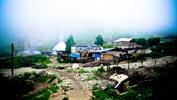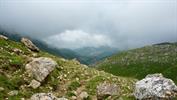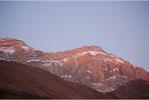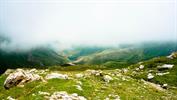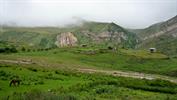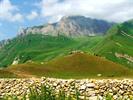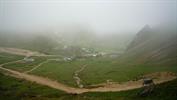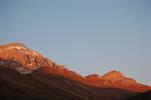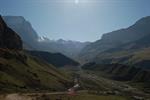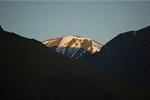HISTORY
Settlement Lazah is located on the northeast spurs of the Main Caucasian Ridge (M.C.R.), at bottom of a high mountainous plateau "Shah Yaylag" and on the highest alps "Shahdag" - its height is 4242 m above the sea level (a.s.l.). The habitation Lazah is located in a mountain hollow in height 1300 m (a.s.l.), on the ancient caravan ways across the passage of the Main Caucasian Ridge (passage Kurve), leading to the Southwest and Northwest spurs of the Big Caucasus. The Vicinity of the village is very picturesque, numerous waterfalls flow down from rocky walls. The village with the similar name is located on this way to the Northwest part of M.C.R., in gorge of the river Damiraparanchaj in the area Gabalah. As to the legend, ancestors of present inhabitants of Lazah (Gusar area) moved there.
In the village live ethnic Lezghins, whose ancestors were the legs, and whose history is connected to the Caucasian Albania - one of the most ancient states in the territory of Azerbaijan. As far back as antique authors wrote about Caucasian-language tribes in the northern part of Azerbaijan, among which the legs are also mentioned, presumably, far ancestors of the modern Lezghins. Historical researches of last time localize the basic ethnic territory of the legs on the left bank of the Samur, in modern southern Dagestan. But during centuries there was a gradual movement of a part of the Lezghin tribes to southern, foothill and about Caspian zones. The Lezghins saved this tendency down to XX century. It is important to note that the historical destiny of the Lezghin people is closely related to Azerbaijan and the Azerbaijani. As far as in days of Arabian and Persian conquest, and also in days of rather independent existence of separate Azerbaijan state formations, the Lezghins entered the same area with the Azerbaijanians and other peoples nowadays occupying the country.
Inhabitants of the village live a usual life of high-mountainous settlements, conduct housekeeping, and hold birds, large horned and fine horned livestock. In summer they drive away the herds on high-mountainous pastures "Shah Yaylag" and "Shah Nabat". Inhabitants talk to each other in the native Lezghin language. The Lezghin language concerns to the Dagestan group of the Caucasian languages and the rich spiritual culture of this people is created in it.
They freely communicate with visitors in the Azerbaijan language. Many middle-aged men speak Russian adequately. Schoolboys study the English language since recently has grown the stream of the foreign tourists making ascensions on the highest plateaus and tops "Shahdag", "Gizil Gaya", "Tufan", "Bazar-Duzu", etc.
The settlement consists of 26 houses, which about 130 inhabitants live in. There is a school with 4- year-education.
WHAT TO SEE
The basic sight of settlement is the mosque of construction of the end of XVIII century and a sacred place "Pir Hajih Seid Baba". Inhabitants worship sacred tombs near to the pir. About 100 years ago this pir was in a rock located in the center of the village. Then this pir was transferred to a rocky wall on village edge near the sacred ancient cemetery. As to inhabitants, below the village, on a slope of the Gusarchaj River there is located a very ancient cemetery. There was saved the tombstone split half-and-half with inscriptions, as local residents consider, in Arabian languages. The part of the cemetery is eroded with rains and earth flows.
In radius from 10 up to 20 kms there are many noteworthy excursion objects around the settlement. Excursions and travel can be made on foot or on horses. Excursions, tourist travel and climbing ascensions are spent by skilled instructors of the tourist pension "Suvar" located in one km higher than Lazah along the gorge of the Gusarchaj.
In vicinities of a boarding house the following excursion objects are located:
- Cave "Tsar" (deep, rocky break in the steep wall of Shahdag massive in length up to 800 м);
- The ancient stone bridge "Gonchy - Muh" across the Gusarchaj River.
- A sacred place (pir) at bottom of lobbies of Shahdag massive.
- Waterfalls on the way to the top of mountain Shahdag (in winter they turning in picturesque Icefalls)
On an opposite slope of the Gusarchaj, against the settlement on a high abrupt hill there were saved remains of the walls of an ancient defensive fortress, in which during attacks and wars inhabitants of the village were hidden. Inhabitants of settlement observe the ancient ceremonies during weddings or other celebrations. Weddings are celebrated separately for men and for women accompanied by national music, when there is an opportunity to invite musicians from the next villages or the regional center. If there is no chance, they use audio records of national lezghin melodies. Weddings are arranged in a courtyard of groom's house for men and in bride's house for women.
National crafts were saved in part. One of the most widespread kinds of lezghins' craft is carpet manufacture. They make "sumakhs" (oriental carpets) - napless carpets with a smooth face sheet and a shaggy wrong side.
It is possible to enjoy national kitchen. During celebrations they bake pies (tskan) with meat and a potato. In a daily life they eat "kutabs" (afar) with greens, meat, entrails. In furnaces - tendirs they bake bread (khizanfah, charavatfah).
There were saved sports lezghin competitions for young men like a struggle "kosa", circulation on a rope. These competitions are organized by the order. There is no museum of ethnographic or regional studies in the habitation.
If you're planning a trip to Azerbaijan you may be interested ▶ Azerbaijan highlights - For those who prefer to go unbeaten path, to explore less visited places and check national charisma of this small country in Southern Caucasus on the edge of Europe.



